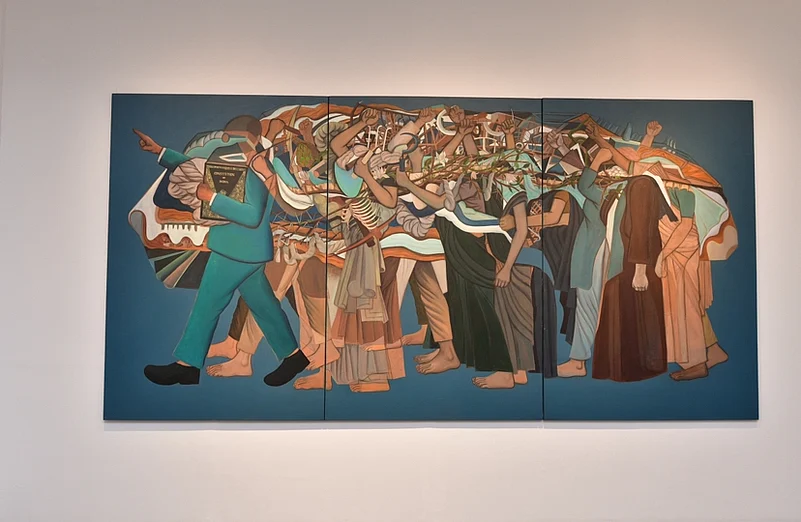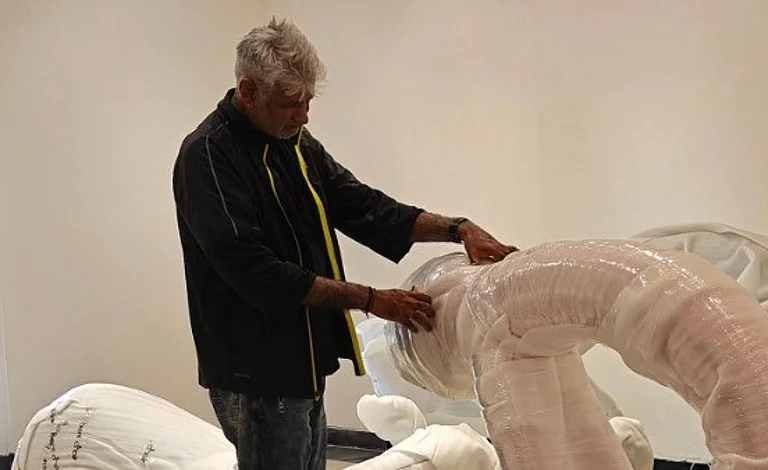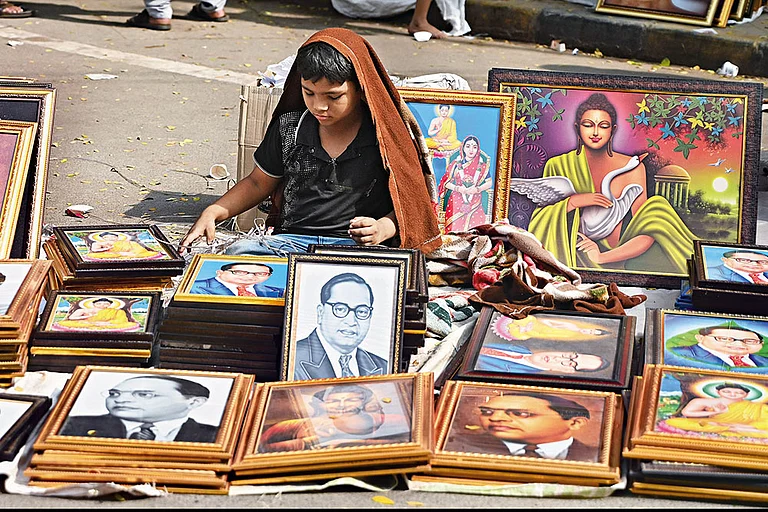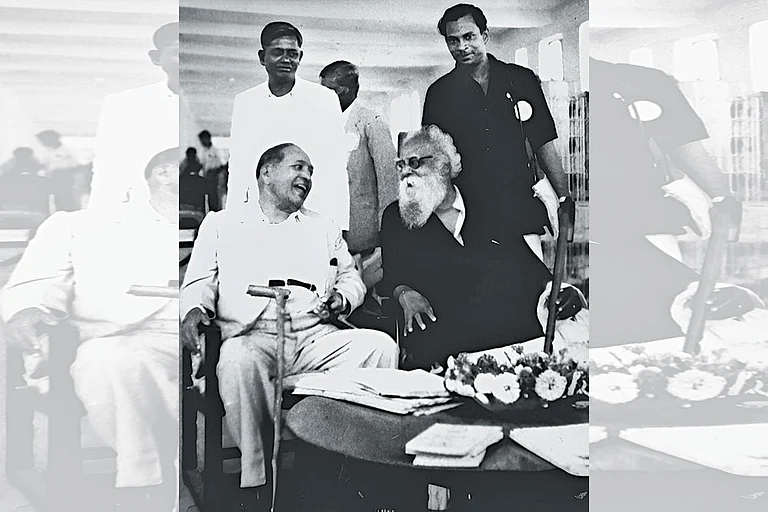Toiling legs with the visible marks of squeezed muscles; bent bodies carrying the burden of unidentifiable objects — mixed with sweat, despair and unabated exploitation; and some nets, axes, and sickles that trap the bodies in the backdrop of the preamble of the Indian Constitution welcome one to the world of the marginalized communities. Painted on blue backgrounds that mostly symbolise the colour of Amebedkarite resistance(s), artist Vikrant Bhise’s canvases in the exhibition titled ‘Sense and Sensibilities’ embody the sense of constitutional freedom, equality, and fraternity.
The solo exhibition curated by art historian Y S Alone at Anant Art Gallery in Noida makes an effort to understand the promises of constitutional democracy through the sufferings of people who live at the margins of society. As one steps into the gallery, paintings of Ambedkar, the portrayal of Mahaparinirvan Janayti, and the preamble of the constitution encapsulate the gaze. It is not a celebration of Savarna ethos and imagination, rather as the curatorial note points out these visuals emerge “from agony, disgust and imposed anarchies on the page of the preamble” and work as a “constant reminder towards responsive self for the citizens of the republic”.

Belonging to an untouchable community himself, Bhise withstood turbulent waters throughout his life. On one hand, he got inspiration from his family members who were closely connected to the Dalit Panthers movement that during the late 1960s-70s mobilised Dalits across western and northern India against the relentless social, economic, and political oppression; on the other, his own early day career as a courier person made him realise the struggles of carrying the burden through an unending path.
“During those days, the couriers had to walk for long. It was not an easy task,” says Bhise. This experience of carrying others’ burdens shaped his series on farmers and labourers whose legs and bent bodies represent the schema of subjugation that only subversive actions to restore constitutional practices can contest.
While writing about Bhise’s journey as an artist, Alone notes, “In 2015, his uncle made sketches based on Namdeo Dhasal’s poetry Golpitha, which had a deep impact on Vikrant. Vikrant could visualise the power of the figure to delineate the Dalit narrative and could address various themes mainly labour caste and migrations in the metropolitan city of Mumbai.”
The burden on the shoulders of these labourers, nevertheless, marks the ambiguity. “Every person has her/his own burden. Sometimes, those are material, in other times these consist of memories,” says the artist. In most of the cases, the faces are replaced with unidentified objects — ranging from farming instruments to the materials for everyday usage.
The artworks in the show overall represent the Dalit artist’s journey from the days of lockdown to the recent protests across India that wanted to subvert the norm to establish constitutional promises. The 40 ft. long canvas where he paints the protests is divided into 10 slides with each portraying a specific moment in recent times — farmers’ protest, anti-CAA movement, mob lynching to name a few. “The paintings on farmers’ protests I made during 2021 when our farmers were fighting for their rights,” says Bhise.
Apart from showing the protests through the united legs marching towards reclaiming their rights, he also shows Ambedkar trapped in rusted sickles in the backdrop of the preamble. “During the protests, the farmers couldn’t use their farming instruments. The abandoned axes and sickles got rust. And they got trapped within,” he notes.
The Protest Series that Alone says, “marks a new beginning for Vikrant”, is not the only space where the sense of being trapped could be realised. In his lockdown series, the use of net that traps the human body upholds the realities of marginalised communities during the Covid-19 days. Interestingly, this was the time when Bhise started reading Ambedkar and Phule’s works extensively. Perhaps this was the watershed moment that shaped his works and made these two pioneer scholars central to his projects.
Referring to the centrality of Phule and Ambedkar in his works, Alone writes, “He is well aware that the educated and acclaimed liberals have been instrumental in blocking Phule-Ambedkar consciousness among the larger public whereas the followers of Ambedkar are diligently consistent in conserving Ambedkar's contribution to the life of every Indian.”
Another space where Ambedkar becomes the fulcrum of his works is the portrayal of Chaityabhumi where the great scholar had been cremated. “Every year during the Mahaparinirvan diwas —December 6, the death anniversary of the Babasaheb— millions of Dalits gather at Chaityabhumi. It is one of the most significant days for us. People here buy several books and Babasaheb’s message of ‘educate, agitate and organise’ finds resonance,” says Bhise. The series titled ‘Jayanti’ and ‘Chaityabhumi’ embody the minute details of the programmes at Chaityabhumi that “people — mostly Savarnas hardly know about”.

In descriptive words of Alone, “The upper part shows a truck carrying cut-outs of Ambedkar’s images and people walking in the front and at the back of the truck. There are also people standing on the truck. A considerable number of women are shown. It is a fact that women have always been part and parcel of the Ambedkar movement and fully took part in the celebration. Youths are shown dancing before the truck and many at the back have raised their hands, shouting slogans. The slogans in such processions generally consist of Jai Bhim! (a salutation formulated by followers of Dr Ambedkar), Babasaheb Amar Rahe! (Long Live Babasaheb!) and many others.”
Notably, the ideology of Ambedkar always finds resonance with that of Martin Luther King who fought against racism. And Bhise didn’t miss the chance to bring them together. In the series titled ‘Pillars of Equality’, his realist strokes show coloured people and Dalits being beaten by the same cane held in the hands of the oppressors — at one place the White men and on the other the Brahmins.
The different lives and livelihoods of Dalits that stem from their memories, struggles, and everyday exploitation also are echoed in the walls of their houses. The ‘Home Wall’ series of Bhise recreates a Dalit household where one can always find either photos of Ambedkar, Jyotiba Phule, or Sabitribhai Phule. Instead of the popular Hindu gods/goddesses, the spaces on their walls are reserved for the ideologues who taught them resistance.
Talking about Bhise’s body of works, Alone says, “The body of work Vikrant has produced is immensely extensive and absorbing, elucidating the process of their significance with objectives integrated into a rational mindset.” The exhibition that started in January will be there till March 16.



























